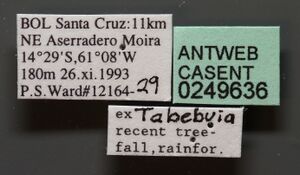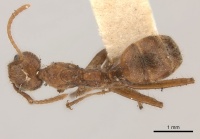Dolichoderus ferrugineus
| Dolichoderus ferrugineus | |
|---|---|

| |
| Scientific classification | |
| Kingdom: | Animalia |
| Phylum: | Arthropoda |
| Class: | Insecta |
| Order: | Hymenoptera |
| Family: | Formicidae |
| Subfamily: | Dolichoderinae |
| Tribe: | Dolichoderini |
| Genus: | Dolichoderus |
| Species: | D. ferrugineus |
| Binomial name | |
| Dolichoderus ferrugineus Forel, 1903 | |
| Synonyms | |
| |
Identification
Distribution
Latitudinal Distribution Pattern
Latitudinal Range: 3.4025° to -10.883333°.
| North Temperate |
North Subtropical |
Tropical | South Subtropical |
South Temperate |
- Source: AntMaps
Distribution based on Regional Taxon Lists
Neotropical Region: Bolivia, Brazil (type locality).
Distribution based on AntMaps
Distribution based on AntWeb specimens
Check data from AntWeb
Countries Occupied
| Number of countries occupied by this species based on AntWiki Regional Taxon Lists. In general, fewer countries occupied indicates a narrower range, while more countries indicates a more widespread species. |

|
Estimated Abundance
| Relative abundance based on number of AntMaps records per species (this species within the purple bar). Fewer records (to the left) indicates a less abundant/encountered species while more records (to the right) indicates more abundant/encountered species. |

|
Biology
Castes
Images from AntWeb
   
| |
| Worker. Specimen code casent0249636. Photographer Will Ericson, uploaded by California Academy of Sciences. | Owned by PSWC, Philip S. Ward Collection. |
   
| |
| Syntype of Dolichoderus ferrugineus. Worker. Specimen code casent0902946. Photographer Will Ericson, uploaded by California Academy of Sciences. | Owned by NHMUK, London, UK. |
Nomenclature
The following information is derived from Barry Bolton's Online Catalogue of the Ants of the World.
- ferrugineus. Dolichoderus bidens r. ferrugineus Forel, 1903c: 258 (w.) BRAZIL. Mackay, 1993b: 56 (q.). Combination in Hypoclinea: Kempf, 1972a: 119; in Dolichoderus: Shattuck, 1992c: 77. Raised to species and senior synonym of inferior: Mackay, 1993b: 56.
- inferior. Dolichoderus bidens var. inferior Mann, 1916: 465 (w.) BRAZIL. Combination in Hypoclinea: Kempf, 1972a: 119; in Dolichoderus: Shattuck, 1992c: 77. Junior synonym of ferrugineus: Mackay, 1993b: 56.
Description
References
- Albuquerque, E., Prado, L., Andrade-Silva, J., Siqueira, E., Sampaio, K., Alves, D., Brandão, C., Andrade, P., Feitosa, R., Koch, E., Delabie, J., Fernandes, I., Baccaro, F., Souza, J., Almeida, R., Silva, R. 2021. Ants of the State of Pará, Brazil: a historical and comprehensive dataset of a key biodiversity hotspot in the Amazon Basin. Zootaxa 5001, 1–83 (doi:10.11646/zootaxa.5001.1.1).
- Forel, A. 1903e. Mélanges entomologiques, biologiques et autres. Ann. Soc. Entomol. Belg. 47: 249-268 (page 258, worker described)
- Franco, W., Ladino, N., Delabie, J.H.C., Dejean, A., Orivel, J., Fichaux, M., Groc, S., Leponce, M., Feitosa, R.M. 2019. First checklist of the ants (Hymenoptera: Formicidae) of French Guiana. Zootaxa 4674, 509–543 (doi:10.11646/zootaxa.4674.5.2).
- Kempf, W. W. 1972b. Catálogo abreviado das formigas da regia~o Neotropical. Stud. Entomol. 15: 3-344 (page 119, Combination in Hypoclinea)
- Mackay, W. P. 1993b. A review of the New World ants of the genus Dolichoderus (Hymenoptera: Formicidae). Sociobiology 22: 1-148 (page 56, queen described)
- Mackay, W. P. 1993b. A review of the New World ants of the genus Dolichoderus (Hymenoptera: Formicidae). Sociobiology 22: 1-148 (page 56, Raised to species, and senior synonym of inferior)
- Shattuck, S. O. 1992c. Generic revision of the ant subfamily Dolichoderinae (Hymenoptera: Formicidae). Sociobiology 21: 1-181 (page 77, Combination in Dolichoderus)
References based on Global Ant Biodiversity Informatics
- Baroni Urbani C. 1977. Katalog der Typen von Formicidae (Hymenoptera) der Sammlung des Naturhistorischen Museums Basel (2. Teil). Mitt. Entomol. Ges. Basel (n.s.) 27: 61-102.
- Emery C. 1913. Hymenoptera. Fam. Formicidae. Subfam. Dolichoderinae. Genera Insectorum 137: 1-50.
- Escalante Gutiérrez J. A. 1993. Especies de hormigas conocidas del Perú (Hymenoptera: Formicidae). Revista Peruana de Entomología 34:1-13.
- Franco W., N. Ladino, J. H. C. Delabie, A. Dejean, J. Orivel, M. Fichaux, S. Groc, M. Leponce, and R. M. Feitosa. 2019. First checklist of the ants (Hymenoptera: Formicidae) of French Guiana. Zootaxa 4674(5): 509-543.
- Kempf, W.W. 1972. Catalago abreviado das formigas da regiao Neotropical (Hym. Formicidae) Studia Entomologica 15(1-4).
- Mackay, W.P. 1993. A review of the New World ants of the genus Dolichoderus (Hymenoptera: Formicidae). Sociobiology 22(1):1-148
- Miranda P. N., F. B. Baccaro, E. F. Morato, M. A. Oliveira. J. H. C. Delabie. 2017. Limited effects of low-intensity forest management on ant assemblages in southwestern Amazonian forests. Biodivers. Conserv. DOI 10.1007/s10531-017-1368-y
- Ortiz C. M., and F. Fernandez. 2007. As formigas do genero Dolichoderus (Hymenoptera: Formicidae: Dolichoderinae) em Colombia. Biologico, Sao Paulo 69(2): 439-441.

